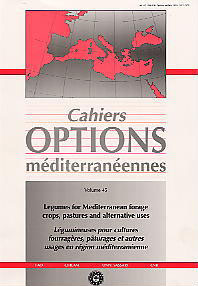| Article précédent | p. 137-140 | Article suivant |
Long term dominance of annual legume species after P application in a Mediterranean rangeland
The herbaceous vegetation in Sarcopoterium spinosum dwarf-shrub communities is the main source of forage for beef cows that graze the range. Changes in the botanical composition of the sward of such a community growing on phosphorus-deficient terra rossa soil overlying hard limestone were studied over a 11-year period. The site was protected from grazing during the growing season in winter but was grazed by cattle in summer. Phosphate fertiliser, applied once only in 1988 at two rates (4.5-9.0 g P m-2), led to the dominance of annual legume species throughout the experiment. Legume dominance was reduced only in two years when there was very little rain at the beginning of the rainy season. The prolonged response of the herbaceous sward patches to a single P application appeared to be caused by the gradual release of phosphate from the applied fertilizer, by recycling through the ungrazed vegetation and seeds.
- [ Afficher ]
- [ Télécharger ]
- [ Exporter la citation ]
Vous pouvez télécharger la citation au format :
- [ Imprimer ]
-
Mots-clés
AMELIORATION DES PLANTES, DYNAMIQUE DES POPULATIONS, FERTILISATION, LEGUMINEUSE, PATURAGES, PHOSPHORECiter cet article
Henkin Z., Seligman N.G. Long term dominance of annual legume species after P application in a Mediterranean rangeland. In : Sulas L. (ed.). Legumes for Mediterranean forage crops, pastures and alternative uses . Zaragoza : CIHEAM, 2000. p. 137-140. (Cahiers Options Méditerranéennes; n. 45). 10. Meeting of the Mediterranean Sub-Network of the FAO-CIHEAM Inter-Regional Cooperative Research and Development Network on Pastures and Fodder Crops, 2000/04/04-09, Sassari (Italy). http://om.ciheam.org/om/pdf/c45/00600183.pdf



